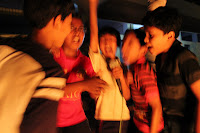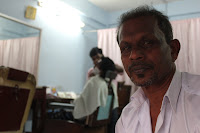
Jenna watches the Oscars Monday morning over a cup of tea.
Hardly anything gets Jenna up before eight in the morning these days. Now that we have no work to accomplish on a day-to-day basis, Jenna finds it utterly appropriate to rise no earlier than 8:30 or 9 am. I can hardly blame her. Most places of business in India do not open until at least 10.
However, she did manage to rouse herself Monday morning by seven. Not so she could read the morning paper with me, or begin a new exercise regimen, or study for the LSAT. No, what was calling her out of bed at (nearly) the crack of dawn was the live broadcast of the 83rd Annual Academy Awards—the Oscars. Though shown in primetime in America, the movie awards show came on at 6 am in India. For the truly hardy, E!’s Red Carpet show started at 4:30. (This proved too early even for Jenna. Luckily Indian TV re-broadcast it on another channel. So we were presented with the odd time-warped reality of watching Natalie Portman talk about her dress with Ryan Seacrest on one channel at the same time that she accepted the Best Actress Award on another.)
If you think it odd that awards for American movies are broadcast in India, remember that Indians still hold up America as the paragon of pop culture. Students in Tirur expressed a love for Michael Jackson and Justin Bieber before the name of any Indian musical artists crossed their lips. At least five channels on Indian cable broadcast English-language movies 24 hours a day with English subtitles so viewers can practice their speaking skills as they watch such Hollywood flops as Crank and Legion. Despite living in India for six months, I still have a remarkably up-to-date picture of Katy Perry’s love life and Charlie Sheen’s ongoing escapades.
India is just as enthralled with celebrity gossip as America is, maybe more so. The only difference between the two countries, as far as I can tell, is the breadth of their respective celebrity universes. In mostly Christian America, there is one God and an ever-growing pantheon of Hollywood stars (swelled by the preening ranks of reality TV noteworthies). In mostly Hindu India, the situation is quite reversed. There is a teeming mass of Hindu gods but only a very selective cast of Bollywood heroes and starlets.
In India, you read about the same eight to ten Bollywood personalities over and over again, and they all fit a particular type. Katrina Kaif is the ‘new kid on the block’, a beauty who critics say lacks any notable acting skill. Priyanka Chopra is the ‘sex symbol striving for a more serious image’. Her latest role has her playing the lead in a movie based on a Ruskin Bond short story, where she kills a series of husbands in whom she finds some fault. Deepika Padukone is ‘the girl next door’ whose image not only graces movie screens but Nescafe and Reliance Mobile advertisements all across the country.
For the males, Shah Rukh Khan is the heavyweight—a ‘nice guy finishes first’ kind of story. He projects the affable yet genuine image of a young man most Indian parents would love to arrange for their eldest daughter’s marriage. Salman Khan is the ‘bad boy’, an edgy star known just as much for his off-screen troubles as his on-screen successes. And Aamir Khan is the ‘intellectual actor’, married to a screenwriter named Kiran Rao, he makes more show of playing down the Bollywood glitz.
Of course, benignly looking down upon this glamorous universe from his perch high atop the fray is none other than Amitabh Bachchan, hands down the most famous Bollywood personage ever. (He was quickly referenced in the movie Slumdog Millionaire a few years ago.) Amitabh is still around making movies, touring the country, and hawking mobile phones and life insurance.
Jenna has said—on several occasions—how handsome he remains at 60-plus years of age. Admittedly, he is tall, slim, tanned, with a distinguished, trimmed gray goatee. Though I think his exaggeratedly circular glasses make him look like an overgrown Harry Potter. He recently cemented his pedigree when he married his son off to former Miss World Aishwarya Rai (maybe the only Indian female besides Padma Lakshmi most Americans would recognize).
All this is to say, that watching the Oscars at 7 am over tea is a rather mundane thing for Indians to do on a Monday morning before they go to work. It is just another chance to watch the beautiful people and comment on what they are wearing.







 The gym teacher Prakash, who has a fine singing voice, led the group in a traditional Hindi song.
The gym teacher Prakash, who has a fine singing voice, led the group in a traditional Hindi song. 






















